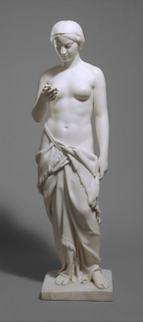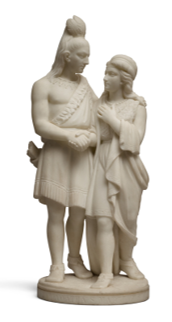Lecture 9: Classicism as Colonisation
1/5
There's no tags or description
Looks like no tags are added yet.
Name | Mastery | Learn | Test | Matching | Spaced |
|---|
No study sessions yet.
6 Terms
Key Ideas
Reliance on Christianity & the classical body to idealise & legitimise indigenous people
Colonial desire to graft ancient Greek culture onto non-Western cultures
Normative template of naturalistic, ideal (white) beauty
Classical form as 1 way in which colonisation becomes visible in art
Aby Warburg’s time in Hopiland
From 1895
In the southwest of North America (later became the state of Arizona)
Goals:
Warburg was interested in ancient myths, magic, & ritual
Wanted to experience a living ancient culture
Idea that indigenous people were a ‘dying race’ - wanted to capture their ways of life before this happened
By the time Warburg arrived, there had already been significant changes to the Hopi way of life
E.g. recent Dawes Allotment Act of 1887
Forced indigenous people to give up their communal ways of life in favour of:
Patriarchal nuclear family models of living
Capitalistic attitude towards private property & land ownership
Took photographs
Incl. photos of secret Hopi rites: he promises not to publish them, but this was violated after his death
In the years after his return, his mental health suffers and he’s admitted into an asylum
To prove his sanity, he gives a lecture about Hopi rituals
Describes its kinship w/ ancient Greek imagery
(A) Colonial desire to graft ancient Greek culture onto non-Western cultures?
OR
(B) Egalitarian endeavour/humanist scholarship that is radically cosmopolitan?
Historical context
19th century European fascination w/ ‘Indian’ bodies
Varied manifestations:
Novels
Plays
Writing, painting
Perversely, indigenous people were facing unspeakable violence in the content of North America & were driven out of their homelands
Social Darwinism
The notion that the indigenous people of America were a dying, vanishing race
The survival & endurance of certain types of bodies over others
The North American Indian by ethnologist & photographer Edward Sheriff Curtis
Photography publication
Intended to record the dwindling cultures of Native American tribes
Argued that the rapid decline in native populations resulting from centuries of conflict w/ European settlers was not only natural, but inevitable
Reliance on both Christianity & classical form to contain, idealise, & sanitise the indigenous body
Eroticising and/or classicising the indigenous body WHILE also signalling its imminent extinction
In sculpture: blending ideal beauty & fantasy of ‘Indianness’
Esp. those carved in marble
Features marking out a body as:
(A) Indigenous
Headgear, costumes
ALTHOUGH often by this time, indigenous people were no longer dressing in these styles
Capitalised on the very qualities that made indigenous people vulnerable to abuse, exploitation, & genocidal attitudes about their existence
E.g. wildness, mystery, an opaque way of life = antithetical to European civilisation
Romanticised idea of a primitive, ‘backwards’ culture
(B) Classical
White European facial features, nudity
Classical civilisation being also long lost serves to yoke the indigenous body to death & disappearance
By BOTH racists & American artists
Many artists who were born/raised in American colonies were quick to seize the currency of this figure
Used their European training to gain credibility
Used their North American origins to lend a sense of authenticity to their depictions of indigenous people
Such works take qualities of Indigenous life and reflect them through the prism of ideal beauty = claim them as part of a European aesthetic tradition
The violence inflicted upon indigenous people is legitimised, fetishised, & presented as an inevitable historical development

The Wounded Indian (1848-50), Peter Stephenson
Historical context
Peter Stephenson
An anglo-American artist born in England, then moved to America
Spent time as a young artist in Rome
Studied Greco-Roman sculpture
The Wounded Indian
Exhibited at the Great Exhibition (1851) in London
Curated according to different nations
This work appeared in the American section
Material: American marble
From a quarry in Vermont
This fact is repeatedly emphasised during its exhibition
Analysis
Figure based loosely on the ancient Roman sculpture ‘the Dying Gaul’
BUT there is some attempt to racialise the figure
Lacking a straightforward Greek profile
Lacking the pulpy, fleshy quality that most Greek sculptures have
Instead, visible sinews, muscles & tendons, not fully smooth
Suicidal gesture of the figure
Wounded indian
Arrow held by the figure themselves
Could be read as pulling out the arrow OR piercing themselves with it
In the context of genocide: idea that indigenous people are, rather than being killed by colonisers, killing themselves
= absolves Americans & European audiences of guilt
Interpretation
Represents an indigenous man as:
(1) A quintessentially American figure, signifying America
(2) A figure possibly in diametric opposition to another burgeoning conception of America
As a civilisation of people of European descent
Kate Flynn:
Do Native Americans carry the symbolic weight of being the country’s original (& hence more authentic) inhabitants?
OR are Native Americans seen as outsiders to American culture, where narratives of ‘American-ness’ are constructed against them?

The Dawn of Christianity (1855-56), Erastus Dow Palmer
Historical context
Palmer spent his entire life in New York
Imbibed classical principles from afar (taught in American academies)
Intended audience: Christian, 19th century Americans
Description
A young Indian maiden wandering listlessly in her native forest, gathering bird plumes
Marked out as indigenous:
Costume & headgear
Marked out as classical:
Naked from the waist up
Facial features
She finds a crucifix
Seen for the 1st time
Gazes upon w/ wonder
Interpretation
Her nudity & face remain obstinately classical
Voyeuristic undertones
She is deeply absorbed in curiosity
The power of the crucifix symbol is so strong that we trust she shares in that power = has no awareness that we are watching her
= allows us to take in her idealised body
Implies the wiping out of indigenous religion in favour of Christian beliefs
Implies the death of identity

The Marriage of Hiawatha (1866), Edmonia Lewis
Historical context
Edmonia Lewis
Was of partly African & Native American descent
It was a crucial part of her self-fashioning as an artist to claim that her mother was pure Ojibwe (Native American)
This was proved likely untrue in reality
Lewis wasn’t actually able to grow up in a reservation because her family had been excluded (mixed race; her father was black)
Worked in the tradition of European naturalism & classicism
The Marriage of Hiawatha
Part of a series of Indian figures (1866-1972)
Based on a popular fictional poem, The Song of Hiawatha, by white American author Henry Wadsworth Longfellow
Based on a legendary Ojibwe figure
Perpetuates the myth of the Noble savage
A stock character who is uncorrupted by civilization
Innate goodness and moral superiority of a primitive people living in harmony with nature
Interpretation
Represents an Indian body as it had been seen through the eyes of a white, male practitioner
Claimed ‘knowledge’ of Indian life
Conforms, in some ways, to a longer lineage of how white European figures (poets, sculptors, painters) have sought to depict & idealise indigenous people
Aesthetic colonisation
At the same time, a statement of Lewis’s own agency & subjectivity as a person of indigenous descent
Reclamation of agency in relation to the indigenous body & identity
E.g. subversively focused NOT on their naked flesh (which historically attracted male collectors) BUT on decorating their bodies in clothing
E.g. Lewis exaggerated her own connection to her Native American ancestry
Used the widespread fascination garnered by ideas of indianness to her advantage
Capitalised on popular culture’s fascination w/ the ‘romantic primitive’ (Myth of the Noble savage)
E.g. fantasised the form & dress of the 2 fictional characters
Reflected her canny understanding of the power of the mythic Indian & white American culture